Consensus polar bear expert Andrew Derocher has been busy over the last few weeks, expounding a story of doom regarding Svalbard area polar bears (e.g. here and here), ridiculing the suggestion that Franz Josef Land is viable alternate habitat for Barents Sea bears, especially pregnant females looking for a place to den and give birth. But the facts say otherwise.
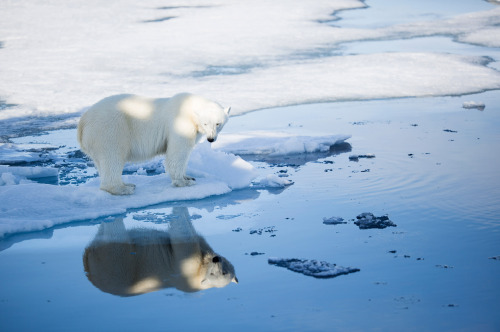
Svalbard sea ice 2nd lowest on record @Istjenesten Poor conditions for #polarbears. Next time a denier says polar bears will be fine, ask them "How will the bears survive without sea ice?" Or "Where do they currently live without sea ice?" It's not complicated: it's habitat loss. pic.twitter.com/nV6Nyb8PNL
— Andrew Derocher (@AEDerocher) December 21, 2017
Below are the long answers, with references and ice maps, to the questions Derocher asked in his 21 December 2017 tweet (above), a refreshing change from the ‘take my word for it, I’m the official expert’ answer one gets from him, along with derogatory slurs directed at those who don’t share his pessimism.
Svalbard sea ice at 2nd lowest level on record yet @UVic #polarbear climate change denier says "females survive bad #seaice falls by going to Franz Josef". It's a >500 km trip one way. Round trip with cubs has no consequences? Really? Ridiculous. pic.twitter.com/vNxBKvcgPi
— Andrew Derocher (@AEDerocher) December 22, 2017
I’ll get back to the text of Derocher’s second, 22 December tweet (above) but first, let’s look at the sea ice conditions to which he draws attention. Ice was indeed low just before Christmas but two weeks later (by 5 January 2018), sea ice coverage around eastern Svalbard had imcreased enormously. The map for the entire Barents Sea (not evident in Derocher’s tweets) shows that the big picture for the region in early January is far from grim. In fact, it’s better than it’s been in recent years:
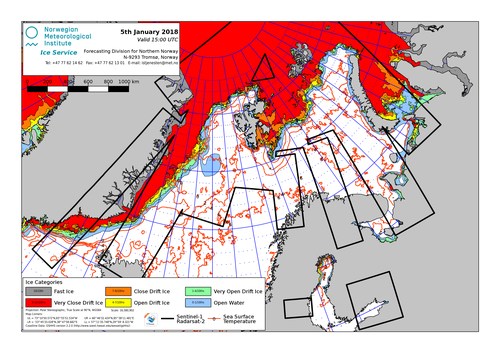
The sea ice this year (2018, above) around Svalbard is much more extensive than last year at this date (2017, below) or for 2013 (below that), conditions from which polar bears subsequently recovered: the number of bears counted in August 2015 around Svalbard were up 42% over the count done in 2004 (Aars et al. 2017).
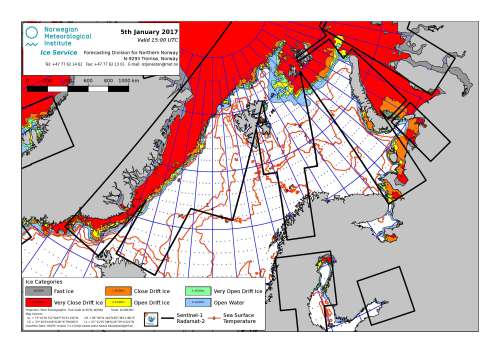
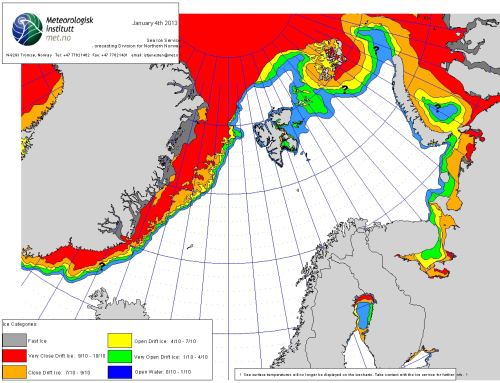
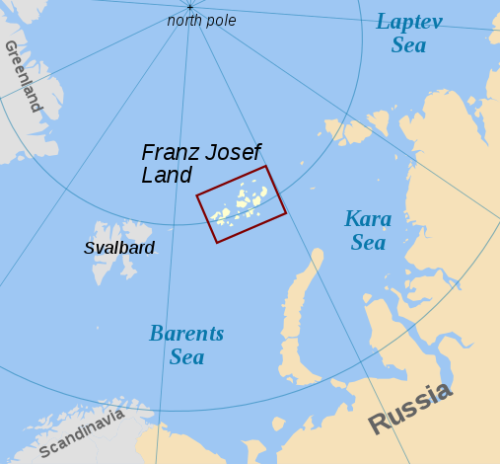
The Franz Josef Land islands are located in the eastern portion of the Barents Sea polar bear subpopulation region. They are managed by Russia, which included all of the islands in their Arctic National Park in 2016 (only some were included in 2009). Only Russian military personnel live there. In contrast, the islands of the Svalbard archipelago directly to the west and under Norwegian control, are one of the best-known areas of polar bear habitat in the eastern Arctic (Andersen and Aars 2016). It has one small town and several small communities on the west coast. Despite Derocher’s focus on Svalbard bears, in 2004 Aars and colleagues (2009) found about three times as many Barents Sea polar bears lived around Franz Josef Land as around Svalbard, which is not surprising given that this is excellent polar bear habitat.
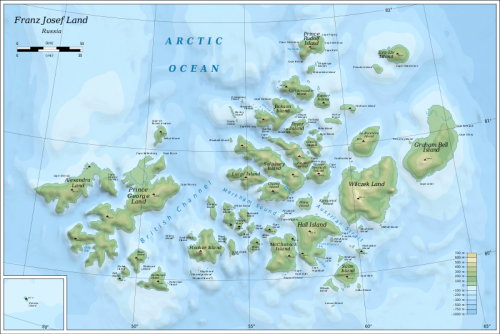
“Franz Josef Land is significantly colder than Spitsbergen, which experiences 8 °C (14 °F) warmer winter averages, but is warmer than the Canadian Arctic Archipelago.” (Wikipedia, citing Barr 1995).
The waters around the Franz Josef Land islands are highly productive (Chernova et al. 2014) and the Atlantic and polar cod that dominate the fish fauna make it excellent habitat for several Arctic seals that are prey for polar bears, including harp, bearded and ringed seals. A National Geographic expedition to the islands in July and August 2013 generated some remarkable film footage of walrus, polar bears and the impressive landscape, see some of them here and here.
Many of the islands are permanently covered in ice sheets (i.e. glaciated), as shown in this NASA satellite image captured 14 August 2011:
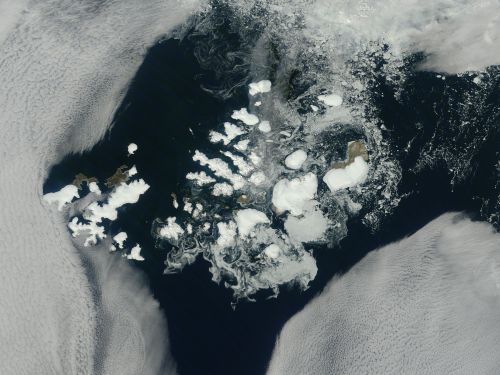
The NASA description of this photo states (my bold):
“Franz Josef Land is an archipelago of 6 main islands and about 135 small islands, with a total landmass of about 16,134 square kilometers (6,229 square miles). The terrain is primarily elevated table lands and low hills, with the highest point rising to 620 m (2034 feet).
The glaciers on the islands of Franz Josef are currently in a state of retreat, and in this image large areas of the main islands clearly appear ice free. However, up to 85% of the island’s landmass is permanently ice-covered, with an average ice thickness of about 180 m (590 feet). On Graham Bell Island (the large island on the eastern edge of the group, the Windy Dome Ice Cap reaches a depth of greater than 500 m (1,640 feet). Although it is late summer, sea ice can still be seen surrounding many of the islands.”
In recent years fall and early winter ice levels have been quite variable around Svalbard and some years pregnant females that did not spent the summer there would have been unable to make dens there because sea ice did not return early enough in the fall (as in 2007, 2012, 2013, 2016).
However, Franz Josef Land has had ice almost year round in all but a few years.
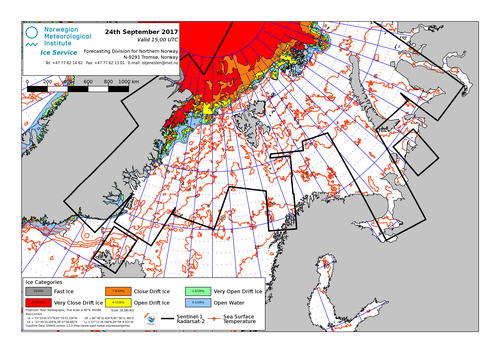
With a few exceptions, there has been some ice around this archipelago even in September and ice enough for any polar bear females that had spent the summer hunting on the pack ice to reach the islands in early fall without difficulty (see 2017, above and Norwegian Ice Service archive here for other years or time periods).
In extremely low ice years (e.g. 2007, and 2012 see below), Franz Josef Land was ice-free from early summer to mid-fall, leaving pregnant bears to either spend the summer onshore (as happens routinely in Hudson Bay and Svalbard) or on the retreating pack ice over the Arctic Basin (as do most Southern Beaufort and Chukchi Sea bears).
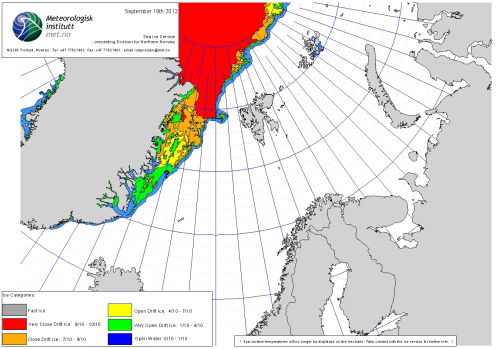
However, even in 2012 enough of the pack had returned to Franz Josef by mid-November to allow pregnant Barents Sea females still on the ice to make landfall and den up for birthing (which usually occurs in late December). While this is later in the season than might be ideal, it clearly was good enough or numbers would have dropped precipitously. Not only had Svalbard bear numbers not declined by 2015 (Aars et al. 2017) but bears that spent the summer around Svalbard were in excellent condition.
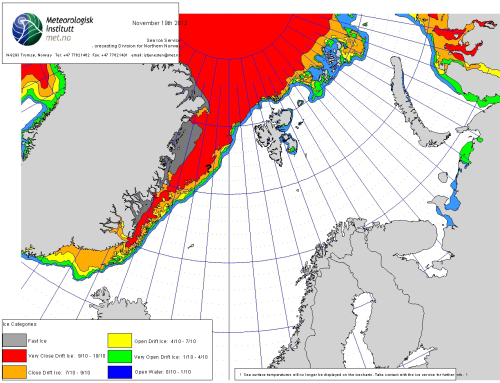
Derocher claims a 500 km trip is a ridiculous proposition for a polar bear with cubs, which is nonsense. Bears with one or two year old cubs have been found to make journeys of that magnitude without trouble (Pagano et al. 2012; Pilfold et al. 2016).
Pagano et al. 2012 in fact concluded: “…we show that both adult female polar bears and their dependent young possess an ability to swim long distances.”
That said, long distance swims are not even necessary for the majority of Svalbard females to take advantage of habitat in Franz Josef Land. If pregnant bears are on the ice hunting over the summer (so-called ‘pelagic’ bears) and lack of ice development to the southwest prevents them from getting to Svalbard in the fall, they can walk to Franz Josef over the sea ice.
The evidence suggests that in poor ice years most Svalbard polar bears abandon Svalbard entirely as a summer refuge and females rarely den there in poor ice years. Only a few hundred Svalbard polar bears seem dedicated to staying close to Svalbard over the summer (Aars et al. 2017) and few of those remain determined to make their dens on east coast islands in poor ice years (see below, from Norwegian Polar Institute website, 9 Jan 2018).
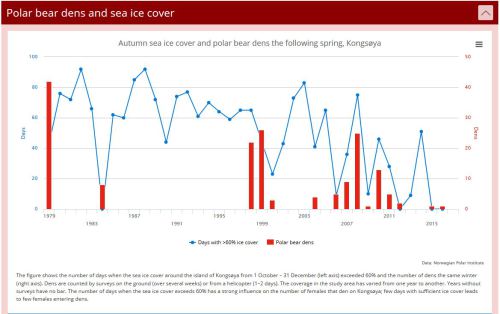
Regarding the data in the above graph, the authors state:
“The occurrence of dens on the islands of Hopen and Kongsøya clearly show that few females reach there in the autumn if the ice comes late, sometime after the first part of November. Whether this means that the proportion of females in the subpopulation having cubs is declining, or they den elsewhere, is not clear.”
As per the quote above, in evolutionary terms, if polar bear females that prefer to den on Svalbard do not adapt to low fall sea ice conditions by denning elsewhere, they are of no use to the survival of the species over time. During low ice decades, females loyal to Svalbard will produce fewer offspring than those that shift to Franz Josef, which means eventually there will be many more bears that are flexible about where to make a den and fewer, if any, that are inflexible.
The conclusion that Franz Josef Land must be an important refuge habitat for Barents Sea polar bears when Svalbard ice is lacking is shared by a number of consensus polar bear experts that have studied Barents Sea bears.
A statement made by Geoff York, then with the WWF in April 2014 (now with Polar Bears International) suggested a shift in denning behaviour was going on in the Barents Sea:
“There is some evidence that the Svalbard population is moving away from traditional denning sites on the Norwegian islands. The bears need to be close to sea ice to hunt when they emerge from their dens. One possibility is that they are moving further east where the ice survives longer.” [my bold]
“Further east” would be towards Russia, to the islands of Franz Josef Land.
More recently, in the peer-reviewed paper by Sébastien Descamps and colleagues (2017:492), the entry in Table 1 on the effects of “climate warming” on polar bears breeding in Svalbard (“fewer pregnant bears reaching traditional denning areas”) has a footnote that reads:
“The effect could be local, as only parts of the Barents Sea area are surveyed, and it is possible that bears den in colder areas in the Russian Arctic when sea ice is scarce in the Svalbard area.”


“…colder areas in the Russian Arctic” would almost certainly be Franz Josef Land — why they don’t come out and say so is perplexing, as Franz Josef Land is considered within the Barents Sea subpopulation region by definition.
Jon Aars, in a presentation given in January 2015, addressed this issue directly after presenting evidence that few, if any, bears den on Kongsøya or Hopen Islands (traditional Svalbard denning areas) when Svalbard sea ice is lacking in the fall:
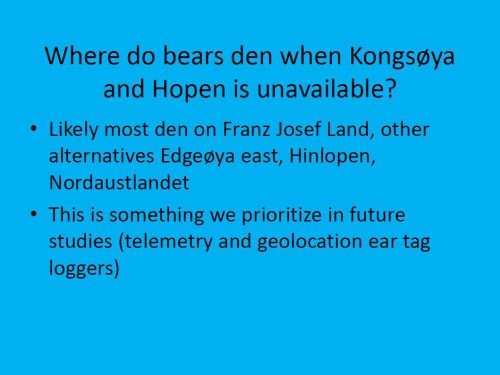
Aars and colleagues (2017:11 ) allude to this point when they conclude that only a small percentage of the Barents Sea population (a few hundred bears) is comprised of individuals that perfer to summer on Svalbard and den there over the fall/winter (what they call the “local” ecotype that are loyal to Svalbard most of the year):
“The bears in the Pack Ice should be assessed as a part of a Russian–Norwegian pelagic Barents Sea ecotype. The reproductive barrier between the two ecotypes has until recently been low (Zeyl et al. 2010). However, pelagic bears visiting Svalbard typically den in the eastern parts of the archipelago, and in years with late sea-ice freeze-up in these areas, none or few females reach the islands for winter maternity denning (Derocher et al. 2011; Aars 2013).
It is likely that the two ecotypes currently experience a fast decrease in overlap both in area and time. We anticipate that in the future, the majority of the pelagic bears will den in Franz Josef Land as they fail to reach the traditional and very important denning areas in eastern Svalbard (Andersen et al. 2012).” [my bold]
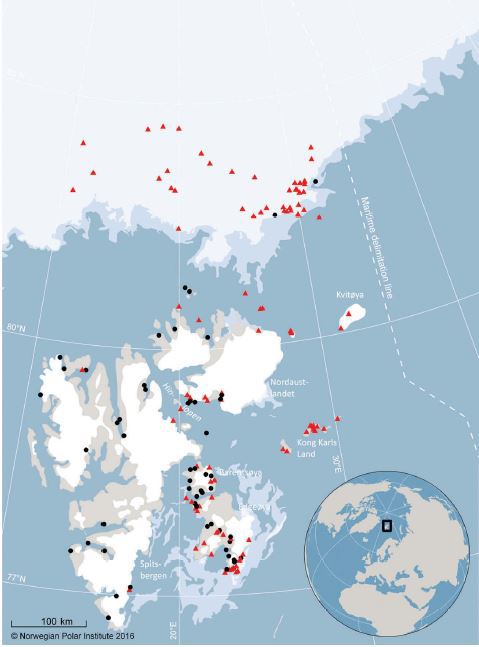
Figure 1 from Aars et al. 2017. Locations of polar bears found during August 2015 survey, after a good ice year when bears were able to den in tradiitional areas on Svalbard. In poor ice years, few bears would have been found, the majority spending the summer north on the pack ice.
Aars et al. (2017:13) point out that a relatively small proportion of the estimated Barents Sea subpopulation surveyed within Norwegian territory (264 bears out of 973 or 27%) seems closedly tied to the use of Svalbard as a summer refuge and fall/winter denning area and the population as a whole would thus not suffer if they did not survive:
“The most significant knowledge from this study is that Svalbard seems to host a local ecotype of the Barents Sea subpopulation of polar bears which constitute only a few hundred individuals. These bears experience different challenges than the much higher number of bears living in the Pack Ice area.”
Since almost 3 times as many polar bears live in the Russian area of the Barent Sea around Franz Josef Land as near Svalbard (Aars et al. 2009), it suggests that the 2015 total for the subpopulation may number close to 3,800, up from about 3,000 in 2004 (Crockford 2017), albeit with a rather large potential error range (which would make the Svalbard-loyal bears less than 10% or so of the total).
While approximately 3,800 bears is not the official population size cited by Aars and colleaagues or the PBSG and thus remains spectulative, it seems unreasonable to assume that abundance of bears in the Russian portion of the Barents Sea would not have risen at least as much as the Norwegian portion, given that productivity of Franz Josef Land is high and sea ice conditions have been generally fairly good. Indeed, a continued population recovery has been anticipated by scientists in the region (Fauchald et al. 2014) after the massive overhunting that went on in this region in the early three-quarters of the 20th century (Andersen and Aars 2016), poor ice conditions around Svalbard notwithstanding.
ReferencesAars, J. 2015. Research on polar bears at Norwegian Polar Institute. Online seminar (‘webinar”), January 14. pdf here.
Aars, J., Marques,T.A, Lone, K., Anderson, M., Wiig, Ø., Fløystad, I.M.B., Hagen, S.B. and Buckland, S.T. 2017. The number and distribution of polar bears in the western Barents Sea. Polar Research 36:1. 1374125. doi:10.1080/17518369.2017.1374125
Aars, J., Marques, T.A., Buckland, S.T., Andersen, M., Belikov, S., Boltunov, A., et al. 2009. Estimating the Barents Sea polar bear subpopulation. Marine Mammal Science 25: 35-52.
Andersen, M. & Aars, J. 2016. Barents Sea polar bears (Ursus maritimus): population biology and anthropegenic threats. Polar Research 35: 26029.
Barr, S. 1995. Franz Josef Land. Oslo: Norwegian Polar Institute. ISBN
82-7666-095-9.
Chernova NV, Friedlander AM, Turchik A, Sala E. 2014. Franz Josef Land: extreme northern outpost for Arctic fishes. PeerJ 2:e692 https://doi.org/10.7717/peerj.692 https://peerj.com/articles/692/
Crockford, S.J. 2017. Testing the hypothesis that routine sea ice coverage of 3-5 mkm2 results in a greater than 30% decline in population size of polar bears (Ursus maritimus). PeerJ Preprints 2 March 2017. Doi: 10.7287/peerj.preprints.2737v3 Open access. https://doi.org/10.7287/peerj.preprints.2737v3
Descamps, S., Aars, J., Fuglei, E., Kovacs, K.M., Lydersen, C., Pavlova, O., Pedersen, Å.Ø., Ravolainen, V. and Strøm, H. 2017. Climate change impacts on wildlife in a High Arctic archipelago — Svalbard, Norway. Global Change Biology 23: 490-502. doi: 10.1111/gcb.13381
Fauchald, P., Arneberg, P., Berge, J., Gerland, S., Kovacs, K.M., Reigstad, M. and Sundet, J.H. 2014. An assessment of MOSJ – the state of the marine environment around Svalbard and Jan Mayen. Norwegian Polar Institute Report Series no. 145. Available at http://www.mosj.no/en/documents/ [accessed 15 February 2017]
Pagano, A.M., Durner, G.M., Amstrup, S.C., Simac, K.S. and York, G.S. 2012. Long-distance swimming by polar bears (Ursus maritimus) of the southern Beaufort Sea during years of extensive open water. Canadian Journal of Zoology 90: 663-676.
Pilfold, N.W., McCall, A., Derocher, A.E., Lunn, N.J., and Richardson, E. 2016. Migratory response of polar bears to sea ice loss: to swim or not to swim. Ecography. http://onlinelibrary.wiley.com/doi/10.1111/ecog.02109/abstract
Share this:





